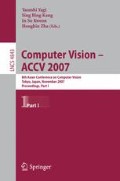Abstract
A new 2-step method is presented for human upper-body pose estimation from depth sequences, in which coarse human part labeling takes place first, followed by more precise joint position estimation as the second phase. In the first step, a number of constraints are extracted from notable image features such as the head and torso. The problem of pose estimation is cast as that of label assignment with these constraints. Major parts of the human upper body are labeled by this process. The second step estimates joint positions optimally based on kinematic constraints using dense correspondences between depth profile and human model parts. The proposed framework is shown to overcome some issues of existing approaches for human pose tracking using similar types of data streams. Performance comparison with motion capture data is presented to demonstrate the accuracy of our approach.
Access this chapter
Tax calculation will be finalised at checkout
Purchases are for personal use only
Preview
Unable to display preview. Download preview PDF.
References
Moeslund, T.B., Hilton, A., Kruger, V.: A survey of advances in vision-based human motion capture and analysis. Computer Vision and Image Understanding 104(2,3), 90–126 (2005)
Sminchisescu, C., Triggs, B.: Kinematic jump processes for monocular 3D human tracking. In: Int. Conf. on Computer Vision and Pattern Recognition, pp. 18–20 (2003)
Knoop, S., Vacek, S., Rillman, R.: Sensor fusion for 3D human body tracking with an articulated 3D body model. In: Int. Conf. on Robotics and Automation, pp. 1686–1691 (2006)
Grest, D., et al.: Nonlinear body pose estimation from depth images. In: Kropatsch, W.G., Sablatnig, R., Hanbury, A. (eds.) DAGM 2005. LNCS, vol. 3663, Springer, Heidelberg (2005)
Buss, S., Kim, J.: Selectively damped least squares for inverse kinematics. Journal of Graphics Tools 10(3), 37–49 (2005)
Kleinberg, J., Tardos, E.: Approximation algorithms for classfication problems with pairwise relationships: Metric partitioning and Markov random fields. Journal of the ACM 49(5), 616–639 (2002)
LP solve reference guide, http://lpsolve.sourceforge.net/5/5
Lewis, J.P., Cordner, M., Fong, N.: Pose space deformations: A unified approach to shape interpolation and skeleton-driven deformation, Siggraph, pp. 165–172 (2000)
Besl, P., McKay, N.: A method for registration of 3-d shapes. IEEE Trans. on Pattern Analysis and Machine Intelligence 14(2), 239–256 (1992)
Anguelov, D., Koller, D., Pang, H., Srinivasan, P., Thrun, S.: Recovering articulated object models from 3D range data. In: Proc. of Uncertainty in Artificial Intelligence Conference, pp. 18–26 (2004)
Ziegler, J., Nickel, K., Stiefelhagen, R.: Tracking of the articulated upper body on multi-view stereo image sequences. In: Int. Conf. on Computer Vision and Pattern Recognition, pp. 774–781 (2006)
Cheung, K.M., Baker, S., Kanade, T.: Shape-from-silhouette of articulated objects and its use for human body kinematics estimation and motion capture. In: Int. Conf. on Computer Vision and Pattern Recognition, pp. 77–84 (2003)
Demirdjian, D., Taycher, L., Shakhnarovich, G., Grauman, K., Darrell, T.: Avoiding the Streetlight Effect: tracking by exploring likelihood modes. In: Int. Conf. on Computer Vision, pp. 357–364 (2005)
Author information
Authors and Affiliations
Editor information
Rights and permissions
Copyright information
© 2007 Springer-Verlag Berlin Heidelberg
About this paper
Cite this paper
Zhu, Y., Fujimura, K. (2007). Constrained Optimization for Human Pose Estimation from Depth Sequences. In: Yagi, Y., Kang, S.B., Kweon, I.S., Zha, H. (eds) Computer Vision – ACCV 2007. ACCV 2007. Lecture Notes in Computer Science, vol 4843. Springer, Berlin, Heidelberg. https://doi.org/10.1007/978-3-540-76386-4_38
Download citation
DOI: https://doi.org/10.1007/978-3-540-76386-4_38
Publisher Name: Springer, Berlin, Heidelberg
Print ISBN: 978-3-540-76385-7
Online ISBN: 978-3-540-76386-4
eBook Packages: Computer ScienceComputer Science (R0)

